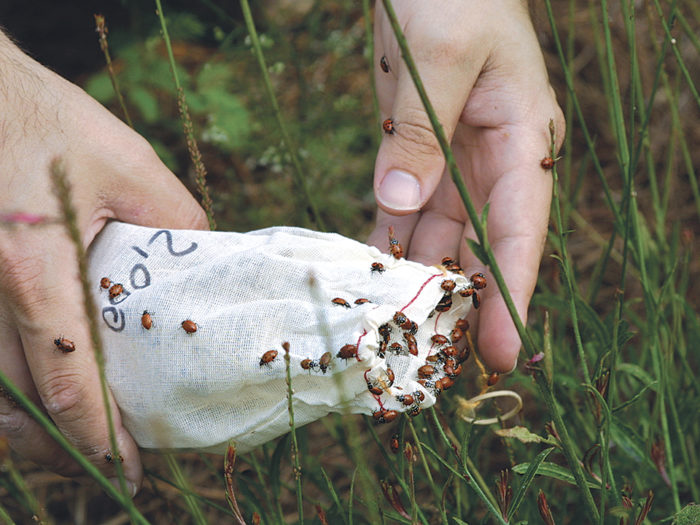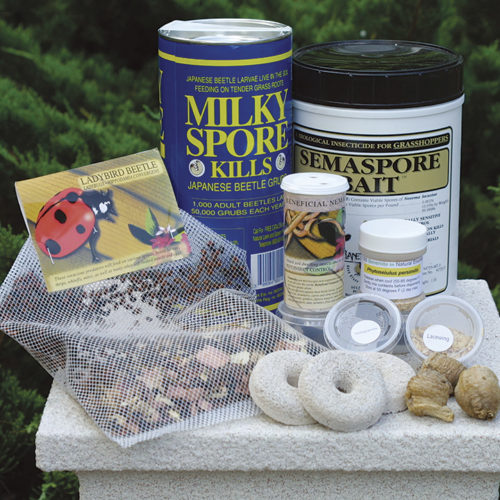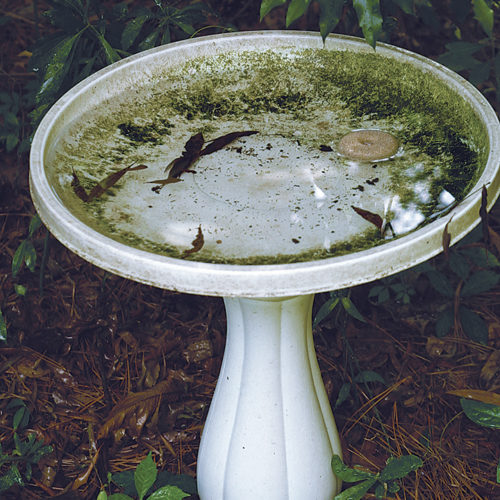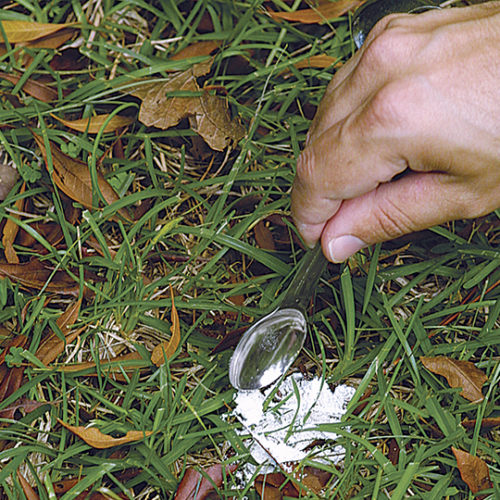Friendly Ways to Battle Garden Pests
Beneficial insects are an environmentally sound alternative to chemicals

I go to great lengths to attract butterflies and birds to my gardens. That’s why, when occasional pest problems arise, I rely on natural means to combat them rather than on chemical remedies that can be harmful to butterflies and birds. By natural means I’m referring to beneficial insects. These bugs are the natural enemies of the pests I’m trying to control. Besides being a less toxic pest control solution, beneficial insects are more effective than chemical remedies over the long term at controlling and preventing pest outbreaks.

These beneficial insects, or good bugs, are already part of the natural ecosystem in my garden, but I add to their populations to ensure that there are enough of them to control certain pest problems effectively. While they occasionally nibble on a few butterfly eggs or larvae, it’s a small price to pay for the numerous benefits of having these insects roaming my garden, patrolling for damaging pests. While beneficial insects are not a cure-all, they are a safe, wildlife-friendly, and highly effective tool for gardeners to use against many common garden pests.
Click here to see a video of the author releasing beneficial insects in his garden.
Identify your problem, then pick your remedy

The first step to using beneficial insects in your garden is identifying what bad bugs are eating your plants. Once you know your pests, you can select the proper controls. Keep in mind that there may be more than one appropriate choice. To increase effectiveness and provide a backup in case something goes wrong with one beneficial, use multiple controls to combat the same pest problem.
You probably won’t find beneficial insects at your local nursery because they don’t have a long shelf life. Instead, you will have to purchase them from a mail-order source. With few exceptions, they will be sent to you via express carrier to lessen the chances of damage or death during shipping. Make arrangements for the package to be left in a protected area if you will be unable to receive it. A box of living organisms left on the doorstep in direct sunlight can quickly overheat, killing its occupants.
When your package arrives, inspect the contents to make sure your order is in good condition. Place the container in a cool, dry location and plan to release the beneficials in your garden as soon as possible. If you are unable to release them right away, don’t panic; most can be stored for a short period of time. The directions enclosed with your order should cover such contingencies.
Most beneficial insects are sold in quantities based on the area they will cover, such as one package per 1,000 square feet of garden space. To determine how much to order you have to know how much space you’re treating. Then you can refer to the vendor’s catalog for amounts.As with conventional pesticides, more is not necessarily better. If your yard is a half-acre, don’t order five acres’ worth of beneficial insects, because most of them will leave your garden in search of food elsewhere or they will starve. Most commercial sources offer detailed information about quantities in their catalogs or will offer excellent customer assistance if you call them, so rely on your sources for technical help in determining what you need for your situation.
6 ways to release beneficial insects
How and when to apply beneficial insects depends on the type of bug you have ordered. You should follow the specific recommendations that come with your insects. In general, you will want to let them go in a protected location out of direct sunlight. The best time to release them is early in the morning or on an overcast day. Your supplier can help you determine if and when you will need to repeat the application.
To hang an egg case, securely fasten a piece of wire, twine, or fishing line around it, threading it with a needle right through the case, if possible. Tie it to a branch or a plant 3 to 4 feet off the ground in a sheltered location hidden by foliage. Some beneficial insect adults or eggs are secured to perforated cards that can be torn apart and attached to the branches or foliage of the infested plants. Others come attached to a tape that can be wound around the branches of a plant. Those released in cases, on cards, or on tape include:
- Praying mantis
- Spined soldier bugs
- Trichogramma wasps
- Whitefly parasite
Sprinkle bugs evenly
Aphid parasites Many beneficial insects will arrive as active, mobile immature insects or adults ready for immediate release. Place a small number of them (1 to 10, depending on the pest density) on an infested plant. Be sure to distribute them evenly throughout the garden. Insects released this way include:
Broadcast granulated materials
 |
 |
Some beneficials arrive in containers mixed with a material like rice hulls, bran hulls, or vermiculite to keep them separated and to help disperse them evenly. Sprinkle a small amount of the mixture onto infested plants, distributing it evenly over the targeted garden space. Those released this way include:
- Aphid predators
- Grasshopper pathogen
- Green lacewing eggs
- Predatory mites
- Spined soldier bugs
- Thrips predator
Spray solutions onto plants or soil
 |
 |
 |
Some beneficial insects come in a powder or as a liquid concentrate that must be mixed with water according to the package directions and applied with a watering can, hose applicator, or a pump sprayer. Be sure to treat the entire space evenly. If you are applying the solution to soil or lawn, water the ground thoroughly before you apply the solution, then keep it moist for the next two weeks. Treatments applied this way include:
- Beneficial nematodes
- Bt (Bacillus thuringiensis)
Place Bt dunks in water
 Bt (Bacillus thuringiensis) is a naturally occurring bacterium that affects various insects, including two bothersome pests, mosquitoes and black flies. It is sold as cakes, or dunks, which resemble hard doughnuts. It is nontoxic to humans, pets, birds, fish, plants, beneficial insects, and wildlife and can be used in ornamental ponds. To use, simply place individual dunks in areas of standing water where mosquitoes and black flies typically breed. One dunk usually covers about 100 square feet and lasts four weeks. As the dunk dissolves, the Bt is slowly released into the water, killing the developing larvae.
Bt (Bacillus thuringiensis) is a naturally occurring bacterium that affects various insects, including two bothersome pests, mosquitoes and black flies. It is sold as cakes, or dunks, which resemble hard doughnuts. It is nontoxic to humans, pets, birds, fish, plants, beneficial insects, and wildlife and can be used in ornamental ponds. To use, simply place individual dunks in areas of standing water where mosquitoes and black flies typically breed. One dunk usually covers about 100 square feet and lasts four weeks. As the dunk dissolves, the Bt is slowly released into the water, killing the developing larvae.
Dust milky spore powder on infected areas
Some beneficial organisms, like milky spore, a bacterium used to control Japanese beetle grubs, come as powders. To treat a target area, apply one level teaspoon of milky spore powder on the turf surface about every three feet in a grid pattern to ensure that the entire area is effectively inoculated. Water the treated area for 15 to 30 minutes when you have finished applying the powder
Important Tips
- For the best product and the best price, shop around. Large, established companies are usually the most reliable.
- Don’t expect immediate results. Like chemicals, beneficials often require multiple applications or regular releases for best control.
- Don’t expect to see all the pests vanish. Natural enemies rely on pest organisms for food, so they will not completely exterminate pest populations or else they would starve.
- If available, use a mix of different kinds of beneficial insects to increase the effectiveness of a treatment.
- Release beneficial insects early in the morning or on an overcast day following the specific recommendations that come with your bugs.











Comments
I basically earn around six to eight thousand dollars monthly with an online job i found on internet. Everyone willing to do simple online work for 2h-5h each day from comfort of your home and earn good paycheck for doing it... Try this job http://ulinks.net/3dc42
We've got some knowledge about getting rid of pets too. Please feel free to check out our post: https://oldgardening.com/how-to-get-rid-of-pests-through-appropriate-cultivation/
Log in or create an account to post a comment.
Sign up Log in